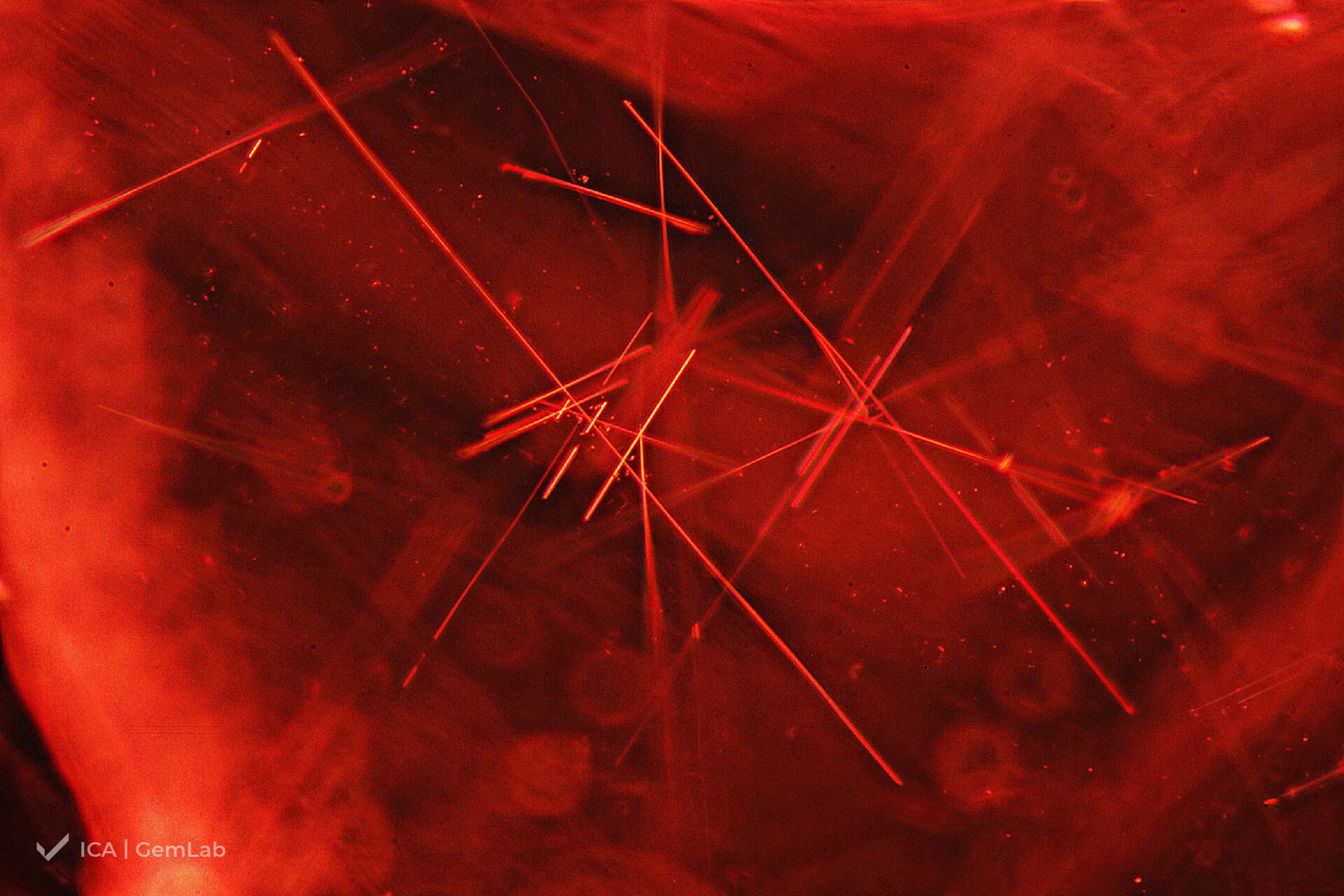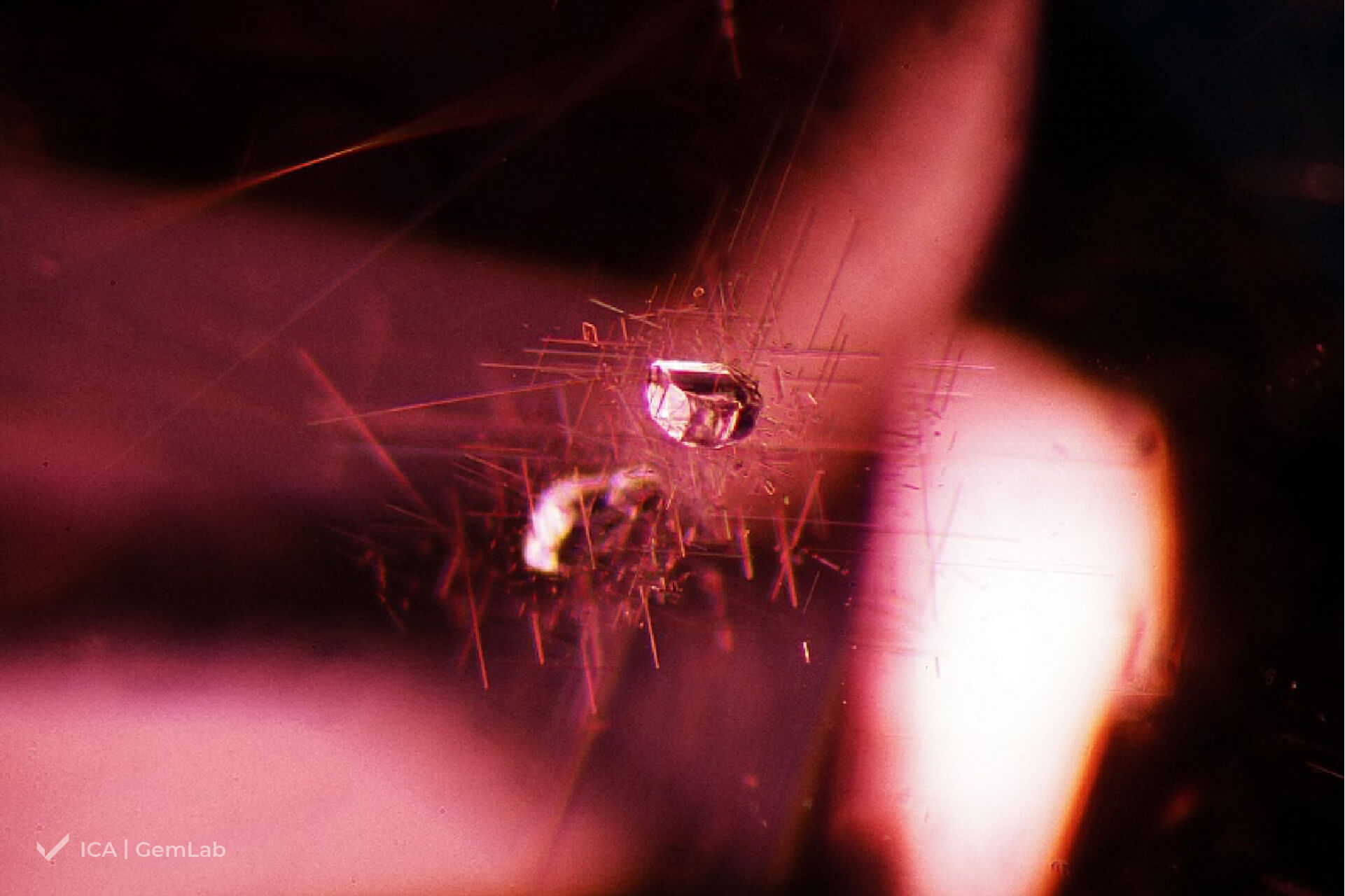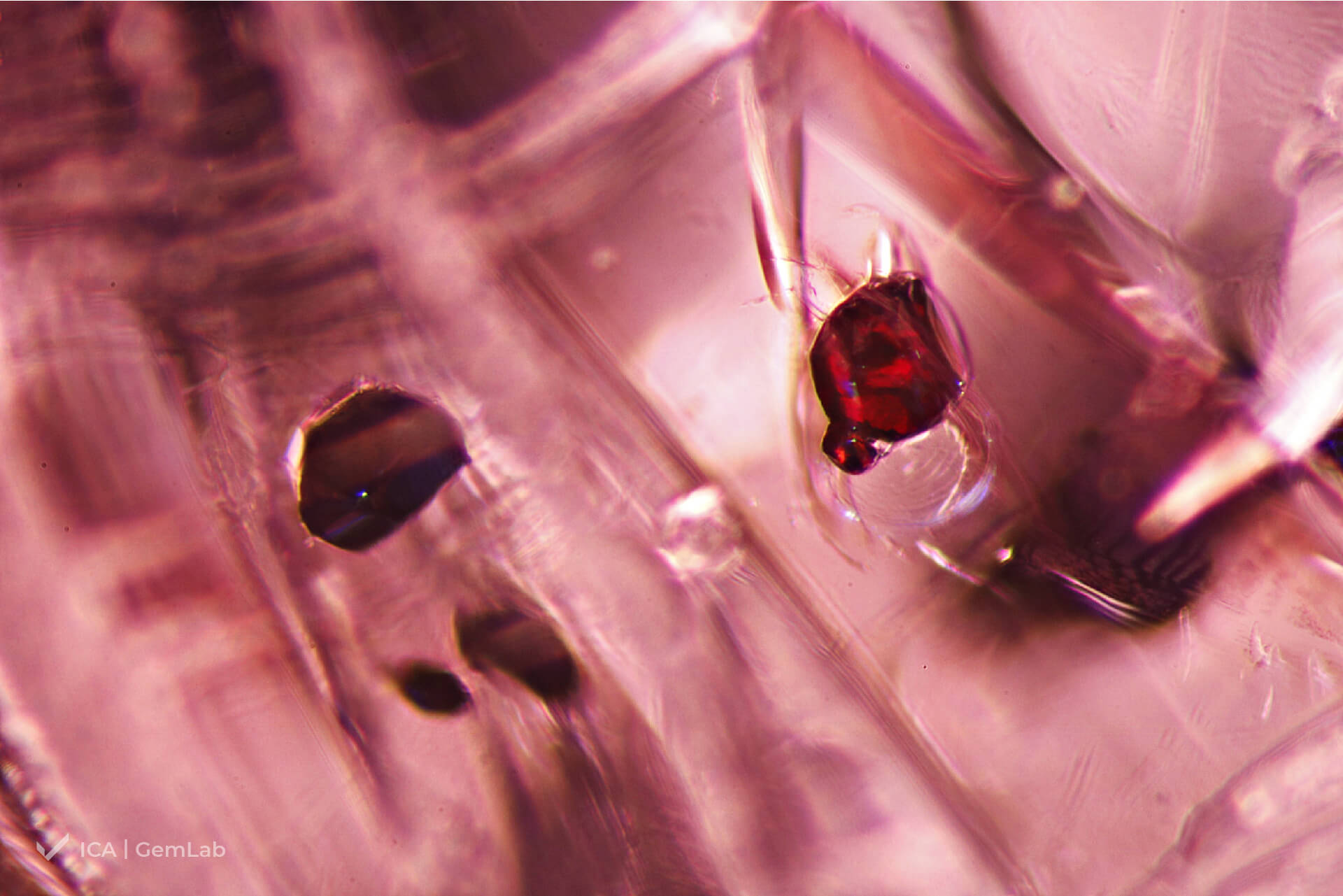Amongst the variety of garnets worldwide, Rhodolite to many is a highly valued and beautiful gemstone for its color and brilliance. This gemstone typically ranges from stunning light pinkish-red to a deep purplish-red hue similar to the classic color of a rose. Rhodolite Garnet is sometimes known as “Rose Garnet” in the trade because of its rosy color.
It is a unique hybrid of two garnet species, pyrope, and almandine. Pyrope is a magnesium-rich variety of garnet known for its deep red color. At the same time, almandine is an iron-rich variety that typically appears in shades of dark red to brown. When these two types of garnet combine, they create the beautiful rosy-pink hue characteristic of Rhodolite.
Rhodolite garnets were first found in the USA, North Carolina. Hidden and Pratts’ 1898 paper “On Rhodolite, a new variety of Garnet” described Rhodolite Garnet as a strikingly beautiful and novel variety of Garnet found over a limited area of western North Carolina. Rhodolite is found in many other locations worldwide, like Tanzania, Sri Lanka, and many more. Inclusions in rhodolite garnet can give clues about the stone’s origin and help the gemologist distinguish between different garnets. Inclusions are a natural part of a gemstone and are considered a source of information to determine a gemstone’s origin.
Hidden and Pratt note that rhodolite garnet generated unusual interest and admiration among mineralogists.
They also provide the type location of rhodolite garnet in Macon County, North Carolina, on a brook called Mason’s Branch. This brook flows southwestward from Lyle Knob, a spur of the Cowee Mountains. This information gives insight into the history and location of the discovery of rhodolite garnet.
While Hidden and Pratt established the type locality and the varietal naming of this “Rhododendron or rose-colored” garnet, the naming of the variety as “Rhodolite” has not always been well received by gemologists as it was deemed too close to “Rhodonite” that used for the manganese-silicate mineral used for an ornamental stone. Given the lack of any scientific, or any other, structure in the establishment of varietal names for gemstones, even today, this area of gemological nomenclature remains problematic (Anderson, 1959) (the IMA only determines species not [commercial] varieties (Grew, 2013). Over time, the varietal name Rhodolite is now well used for garnets that are a lovely “rhododendron-red,” a pyrope-almandine mixture that may be closer to the pyrope having a density comparable to 3.84 and an index of refraction close to 1.76 (Webster, 1983).
The peculiarities which distinguish this garnet from the ordinary occurrences of the species are its variety of shades and tints, for the most part, similar to those belonging to the rhododendrons and roses; its surprisingly small amount of coloring matter; its gem-like transparency; its freedom of internal imperfections, microscopic inclusions and striae, all so universally characteristic of common garnets; also, its remarkable brilliancy when cut as a gem. These shades of color made the Rhodolite Garnet one of the most captivating garnets in the Garnet family.
Rhodolite garnet is found in many locations worldwide, including Zimbabwe, Tanzania, Sri Lanka, Madagascar, India, Myanmar, Mozambique, and the USA. However, the most significant deposits are in Tanzania and Sri Lanka. The North Carolina deposits are depleted in the number of deposits of rhodolite garnets. Most of the rhodolite garnet deposits are now in Asia and Africa. Its color can vary depending on the location where it was mined, and it can have a range of inclusions that provide valuable information about its origin and formation.
The inclusion scenes within rhodolite garnet, all garnets, have provided gemologists with hours of fascinating studies. These, therefore, reflect this continuous enthusiasm for these fascinating gems:

Needle-like inclusions
Needle-like inclusions oriented in different directions (possibly rutile) are seen here using dark field Illumination, field of view 1.55 mm : Photo by Muzdareefah Thudsanapbunya (Jayda)© ICA | GemLab.
The first image is of Oriented needle-like rutile inclusions in a three-dimensional network recorded in the photomicrograph of the interior of a rhodolite garnet in this image. These internal features are commonly found in rhodolite garnets and other garnets from pyrope-al-mandine series.
Colorless-transparent crystals
Colorless-transparent crystals (possibly quartz) associated with needle-like inclusions (possibly rutile) is seen here using dark field Illumination, field of view 1.55 mm
: Photo by Muzdareefah Thudsanapbunya (Jayda) ICA | GemLab.
The second image shows interference color thin-film inclusions commonly found in the pyrope-almandine garnet series imaged using oblique fiber optic illumination.
The third image shows Brownish red crystals (possibly sulfide) are seen here using oblique fiber optic illumination.
Slightly rounded, colorless-transparent crystals
Slightly rounded, colorless-transparent crystals is seen here using dark field Illumination, field of view 1.95 mm: Photo by Muzdareefah Thudsan- apbunya (Jayda) ICA | GemLab.
This stone in image four has colorless-transparent included crystals that display slightly rounded aspect and are possibly apatite. A thin high-relief negative crystal, which, unlike thin-film inclusions, does not display interference colors (see Image six) is recorded in a rhodolite garnet.
Image five, This negative crystal is possibly filled with either a gas or liquid phase (Sun, 2015). Thin film inclusions are commonly found in the pyrope-almandine garnet series (Sangsawong, 2016; Sripoonjan, 2016), so it was no surprise to discover these in the rhodolite garnet depicted in image 5.
In Image Six, These inclusions and their interference colors are imaged using oblique fiber optic Illumination (OL).
The primary benefit of oblique illumination (OL) is the potential to enhance the resolution of a light microscope by effectively doubling the angular aperture. However, a drawback of OL is that its ability to improve resolution is directional and depends on the orientation of the oblique mask.
This beautiful rose-colored garnet should be a statement piece in every jewelry wardrobe and not be forgotten by the trade. The specialty of this gemstone is its beautiful rosy pinkish, reddish, and purplish color, not found in any other garnet species. Each color shade and inclusion can help determine the location of a garnets origin. The price of a gemstone can fluctuate by its color and origin in the market.
This research initially appeared in GAMMA, the ICA | GemLab journal. It has been edited to reach a broader audience in the gemstone industry, enthusiasts, or someone interested in gemstones.
If you would like to read the original unedited research, you can download the Gamma issue it appeared in here.
Table 1: A useful listing of the end members of the gemologically recognized garnet species extracted from (Grew, 2013)
Almandine
End-member formula: {Fe3}[Al2](Si3)O12 Group: Garnet
IMA number: Grandfathered Modifications: None
Etymology: The “Alabandic carbuncles” of Pliny were so named as they were cut and polished in Alabanda (Dana 1837, 1892), an ancient city in what is presently Aydin Province, Turkey.
Type locality: Not known
Crystal system, space gWroup and structure refinement: Isometric, Ia3d. Novak and Gibbs (1971); synthetic material: Armbruster et al. (1992).
Original or oldest description: Known in ancient times. Name first used by D.L.G. Karsten in 1800 (Dana 1892).
Andradite
End-member formula: {Ca3}[Fe2](Si3)O12 Group: Garnet
IMA number: Grandfathered Modifications: None
Etymology: For José Bonifácio de Andrada e Silva (1763–1838), the Brazilian mineralogist who described a variety under the name “allochroite” in 1800 (Dana 1892; Clark 1993).
Type locality: Not known
Crystal system, space group and structure refinement: Isometric, Ia3d. Armbruster and Geiger (1993). Original or oldest description: “allochroite” of de Andrada in 1800 and “melanite” of Werner in 1800 (Dana 1892).
Grossular
End-member formula: {Ca3}[Al2](Si3)O12 Group: Garnet
IMA number: Grandfathered Modifications: None
Etymology: From the color resembling gooseberry, Ribes grossularia (Dana 1892; Clark 1993).
Type locality: Wiluy River, Sakha-Yakutia Republic, Russia.
Crystal system, space group and structure refinement: Isometric, Ia3d. Novak and Gibbs (1971).
Synthetic material: Geiger and Armbruster (1997). Original or oldest description: A.G. Werner in 1808– 1809. However, grossular was described earlier under other names, viz. as “Cinnamon Stone” (Kanelstein) from Sri Lanka by Werner in 1803–1804 and as “Granat” by Pallas in 1793 (Dana (1892).
Pyrope
End-member formula: {Mg3}[Al2](Si3)O12 Group: Garnet
IMA number: Grandfathered Modifications: None
Etymology: From the Greek πνρωπός (pyropos) – fire- like for its deep-red color.
Type locality: Bohemia (Czech Republic).
Crystal system, space group and structure refinement: Isometric, Ia3d. Novak and Gibbs (1971)
Synthetic material: Armbruster et al. (1992)
Original or oldest description: Recognized by Georgius Agricola (1546), but the name pyrope was introduced by A.G. Werner in 1800 (Dana 1892; Clark 1993).
Grossular
End-member formula: {Mn3}[Al2](Si3)O12 Group: Garnet
IMA number: Grandfathered Modifications: None
Etymology: From the Spessart Mountains, Germany. Type locality: Sommer quarry, Wendelberg Mt., Spessa- rt Mountains, Bavaria, Germany.
Crystal system, space group and structure refinement: Isometric, Ia3d. Novak and Gibbs (1971); for F-bearing, Smyth et al. (1990).
Synthetic material: Geiger and Armbruster (1997) Original or oldest description: Recognized by M.H. Klaproth (1797), but the name spessartine was intro- duced by F.S. Beudant (1832) according to Dana (1892) and Clark (1993).
Uvarovite
End-member formula: {Ca3}[Cr2](Si3)O12 Group: Garnet
IMA number: Grandfathered Modifications: None
Etymology: For Count Sergei Semenovich Uvarov (1786–1855), a Russian historian.
Type locality: Saranovskiy mine Biserskoye chromite deposit, Perm district, Urals, Russia (Pekov 1998). Crystal system, space group and structure refinement: Isometric, Ia3d. Novak and Gibbs (1971)
For birefringent uvarovite: Wildner and Andrut (2001) Original or oldest description: Hess (1832)
About the Writer
About the Writer

Ken Scarrat
Scarratt is considered by many in the gem and jewelry industry media to be one of the leading pearl authorities in the world. He has extensive experience in researching and identifying a broad range of pearl materials and detecting treatments. His expertise in saltwater and freshwater natural pearls includes the rare Melo pearl. In 1999, Scarratt co-authored The Pearl & the Dragon – the definitive study of Oriental pearls.
As always, please find our sources below;
Anderson, B. W. (1959). Properties and classification of individual garnets. Jour- nal of Gemmology, 7(1), 1-5.
Campbell, I. C. C. (1972). A comparative study of Rhodesian rhodolite garnet in relation to other known data and a discussion in relation to a more acceptable name. Journal of Gemmology, 13(2), 53-64.
Campbell, I. C. C. (1973). A gemological report on rhodolite garnet, Malagasy. Lap- idary Journal, 27(6), 958-960.
Grew, E. S., Locock, A.J., Mills, S.J., GaluskIna, GaluskIn, Hålenius, U. (2013). Nomen- clature of the garnet supergroup. American Mineralogist, 98, 785–811.
Gübelin, E. J. (1973). Internal World of Gemstones (reprinted 1983 ed.). Zürich: ABC Verlag.
Gübelin, E. J., & Koivula, J. I. (1986). Photoatlas of Inclusions in Gemstones. Zürich, Switzerland: ABC Edition.
Gübelin, E. J., Koivula, J. I. (2005). Photoatlas of Inclusions in Gemstones (Vol. 2). Basel, Switzerland: Opinio.
Gübelin, E. J., Koivula, J. I. (2008). Photoatlas of Inclusions in Gemstones (Vol. 3). Basel, Switzerland: Opinio.
Hidden, W. E., & Pratt, J. H. (1898). On rhodolite, a new variety of garnet. American Journal of Science, 155(28), 294-296.
Hlaing, U. T., & Win, T. T. (1996). Mong Hsak rhodolite garnet. Australian Gemmol- ogist, 19(6), 270-272.
Kammerling, R. C., & Koivula, J. I. (1990). Star rhodolite garnet from Tanzania. Journal of Gemmology, 22(1), 16-18.
Koivula, J. I., & Kammerling, R. C. (1991). Rhodolite from Orissa. Gems and Gem- ology, 27(1), 50.
Martin, B. F. (1970). A study of rhodolite garnet. Journal of Gemmology, 12(2), 29- 36.
Sangsawong, S., Raynaud, V., Pardieu, V. (2016). Purple pyrope-almandine garnet from Mozambique. Gems & Gemology, LII(3), 321-323.
Sripoonjan, T., Maneekrajangsaeng, M., Jakkawanvibul , J., Leelawatanasuk, T. (2016). A New “Purple Rhodolite” Garnet from Mozambique: Its Characteristics & Properties. Paper presented at the Conference: GIT2016 Pattaya, Thailand.
Sun, Z., Palke, A.C., Renfro, N. (2015). Vanadium and Chromium Bearing Pink Py- rope Garnet: Characterization and Quantative Colormetric Analysis. Gems & Gemology, 51(4), 348-368.
Webster, R. (1983). Gem their sources, descriptions and identification. 690-696.






